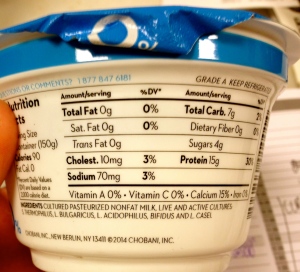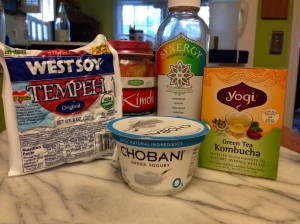When
the word bacteria is mentioned, I would imagine that for many of us,
things like Clorox wipes, Soft Soap and trash bags come to
mind. Although the word may have a generally negative connotation,
bacteria can go both ways, just like people. Meet your intestinal
microbiota. This term microbiota refers to the good bacteria or
probiotics that live inside the body and help to keep you healthy. When
we eat foods that contain these probiotics, they inhabit our digestive
tract and perform many functions to help with digestion, processing of
nutrients and the body’s immune defense against pathogens.
Our
bodies are exposed to pathogens countless times throughout the day; one
major source for these potentially harmful microorganisms is in the
substances that we ingest. Sometimes the food we eat contains
potentially harmful bacteria, fungus or other pathogenic substances. As a
part of the mucosal barrier in the intestines, the microbiota functions
in the first level of immune defense against these substances. They
recognize and signal the immune system to initiate an inflammatory
response in order to defend and rid the body of the pathogenic cell. In
turn the microbiota also initiates an anti-inflammatory response once
the pathogenic material has been rid of in order to restore the gut
environment back to normal. Failure of this anti-inflammatory action to
occur could play a role in development of certain conditions like IBD or
IBS.
The microbiota also helps the body to digest the foods we eat, absorb some of the nutrients from those foods as well as promote
digestive regularity. Some gut bacteria help to produce essential B
vitamins such as vitamin B12, folate, vitamin B6, biotin, niacin, and
thiamin which are needed for proper carbohydrate metabolism. These
bacteria also help to synthesize vitamin K which is important in proper
coagulation and clotting of the blood. The fiber in certain cruciferous
vegetables like cabbage, brussel sprouts, cauliflower and broccoli is
digested and fermented as a fuel source for the gut bacteria.
When the bacteria digest the fiber from these foods, it leads to an end
product of short-chain fatty acids, which also help to regulate
inflammation in the gut. These short chain fatty acids
help to regulate intestinal acid-base balance, fat, carbohydrate and
cholesterol metabolism . This is one of the many reasons why consuming
vegetables is such a crucial component to a healthy diet and a happy
digestive system.
Probiotics are especially noted for their role in gut health, this can be especially beneficial
in those experiencing consistent symptoms of constipation or digestive
discomfort or those who battle certain digestive diseases and may
help to reduce symptoms of gas and bloating as well. For those who participate in regular, intense and/or long-duration exercise,
the gastrointestinal lining can get irritated and thus lead to
non-desirable symptoms such as diarrhea, bloating, cramping and pain.
Consuming probiotics can help to significantly reduce the amount of
symptoms experienced, especially for those who are prone to these
issues.
In addition to a happier digestive system, probiotics are a key player
in a healthy immune system. A flourishing microbiota could help to
reduce the duration or number of occurrences of certain illnesses. This
immune-enhancing effect could be particularly useful for athletes and
highly active folks under rigorous training.
The effect of a high training load can damper the effectiveness of the
immune system and leave one more vulnerable to upper respiratory
illness. Supplementation with probiotics or regular consumption of food
sources of probiotics could help to reduce the incidence and duration of
upper respiratory illness symptoms, especially if you are one who has a
tendency to experience illness when under training.
 |
| Note the live and active cultures listed in the ingredients. |
Two ways. Either by consuming a probiotic supplement (usually in capsule or powder form) or certain foods. Yogurt is the most recognizable source for most of us, but you can get some probiotics from other dairy products as well. Another source is Kefir, or
fermented milk. This is usually found in multiple flavors with the other
dairy products and is a slightly more acidic, thicker substance than
milk. Pickled, fermented vegetables, such as Kimchi, a Korean spicy
blend of vegetables and spices, or Sauerkraut, can provide another
source for gut healthy bacteria. Fermented soy products like tempeh,
miso and natto are sources as well. Both tempeh and natto also offer the
benefit of being good vegetarian protein sources. Double whammy with
these foods. Lastly, beverages and tea blends made from kombucha
mushrooms can be another good source of probiotics. I’ve grown fond of
several varieties of these which are found in the refrigerated juice
section of many grocery stores and health food stores. Tangy and
effervescent in taste they are quite a refreshing treat on a hot
afternoon or not a bad replacement for a soda craving! You can also find
some tea blends containing kombucha in the tea section of your local
market.
 |
| A few natural sources of probiotics |
Like
all nutrients, whole foods are best when trying to increase your
probiotic consumption. However, if supplementation is more sensible or
is of interest to you, work with your doctor and local dietitian to
determine if probiotic supplementation would be appropriate and if so
what variety would work best for you.
References
Aureli, P., Capurso, L., Castekkazzi, A. M., Clerici, M., Giovannini, M., Morelli, L., et al. (2011). Probiotics and Health: an evidence-based review. Pharmacol Res , 63, 366-376.
Besten, G., Eunen, K., Groen, A. K., Venema, K., Reijngoud, D., & Bakker, B. M. (2013). The role of short-chain fetty acids in the interplay between diet, gut microbiota, and host energy metabolism. J Lipid Res , 54 (9), 2325-2340.
Getz, L. (2011, October). A Healthful Dose of Bacteria–Yogurt is the Best Probiotic Source, but Clients Do Have Other Options. Today’s Dietitian , 13 (10), p. 46.
Pyne, D. B., West, N. P., Cox, A. J., & Cripps, A. W. (2014). Probiotics supplementation for athletes-Clinical and physiological effects. Eur J Sport Sci , 15 (1), 63-72.
Vandenplas, Y., Huys, G., & Daube, G. (2014). Probiotics: an update. J Pediatr , 91 (1), 6-21.
Vitetta, L., Briskey, D., Alford, H., Hall, S., & Coulson, S. (2014). Probiotics, prebiotics and the gastrointestinal tract in health and disease. Inflammopharmacol , 22, 135-154.
No comments:
Post a Comment